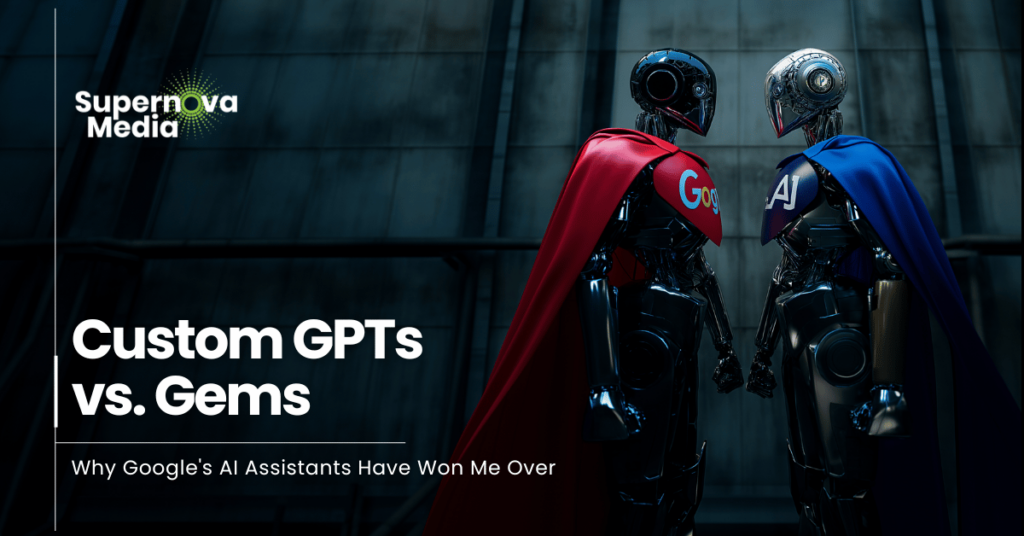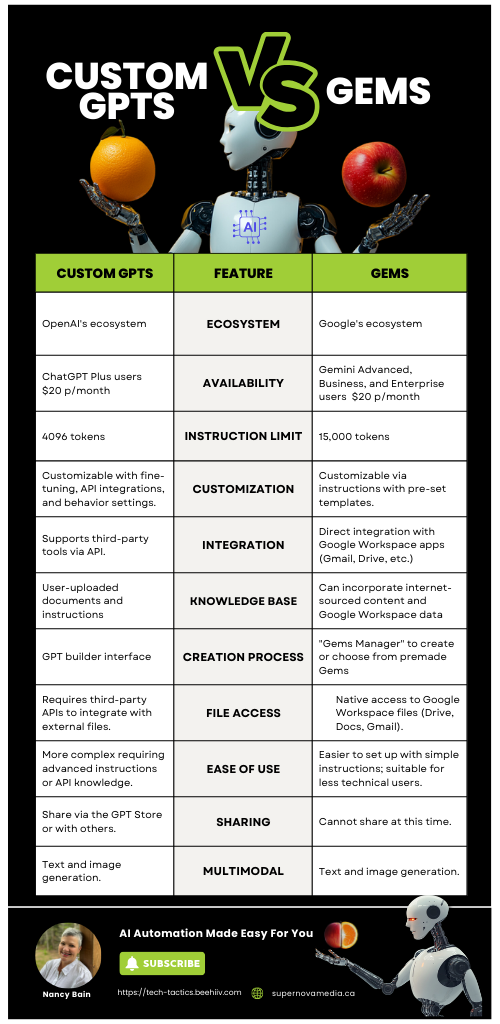|
Getting your Trinity Audio player ready...
|

As a solopreneur for more than two decades, I’ve been using Google Workspace as a secure, flexible, efficient, and affordable solution for productivity tools. The last year and a half have been about exploring AI tools like ChatGPT that can enhance my productivity, streamline and optimize my operations, – so today I’m comparing Custom GPTs vs Gemini Gems. Let’s get to it:

OpenAI’s Custom GPTs and Google’s Gemini Gems are both examples of personalized AI assistants. They are tailored versions of their respective AI’s, and custom designed (by you) to specific use cases. For me – they take care of everything from 15-minute meal ideas to managing my online store and finding daily motivation.
Launched August 28th, Gems are available to premium users. We’ll learn more about them below. And here’s everything you need to know about Custom GPTs.
Side note: I recently polled my LinkedIn audience to see which productivity tool they were using. Looks like I’m in good company. 😉
Back to Custom GPTs vs Gemini Gems. I’ve been building Custom GPTs since their launch in November 2023 with 21 in my Arsenault. Sound cumbersome? It is… As a die-hard Google Workspace user, I have to say: I’m sold on Gems.
Here’s why:
1. User-Friendliness is King
One of the biggest reasons I’m sold on Gems is how easy they are to set up.
PyPilot was one of the first GPTs to hit the GPT Store – designed as an interactive course to teach Python to beginners. And within hours – there were six iterations available. 😡 But that’s another story. Don’t bother search for it – it’s unpublished – and I won’t be publishing anymore. Read the PyPilot case study here.
PyPilot’s use case was unique. I didn’t want the bot to “think” – the goal was that every user would have the (exact) same experience – which required a script. Achieving this was time-consuming with many iterations and fine-tuning and I learned to structure my files consistently using markdown. Learn how to structure your data for GPT’s.
Despite every best practice, the results remained inconsistent.
And I wasn’t the only one who felt that way:.
So I tried harder…. And for each of my Custom GPT “major players,” I established a framework in Notion that looks like this:
Spoiler alert – the results are improved but definitely not perfect. 🤷🏻♀️
For beginners, I love that Gemini Gems come with pre-set templates. This makes it less scary for some and a great choice for newbies. You simply provide instructions (up to a massive 15,000 tokens), name your Gem, and you’re ready to roll!
2. No Need for Manual File Uploads
This is a game-changer. With Custom GPTs, if you want the AI to access specific documents or data, you have to upload those files or feed them manually. Gemini Gems completely eliminate that hassle by tapping directly into your Google Drive, Docs, and Gmail. They dynamically access files in real-time, which means that as you modify or update your files, your Gems get access to the most recent data—automatically!
Imagine you’re working on a project where you update in Google Sheets. Your Gem will automatically incorporate those changes without needing you to re-upload the document. (happy dance)
I’ll still follow the framework established in Notion, but the database will go by the wayside in favor of hosting my files on Drive. This will make my workflow so much more efficient!
3. Dynamic Updates with Real-Time Data
If you’re a Custom GPT builder, you know it’s an iterative process and real-time dynamic updates are where Gemini really shines. As I modify files in my Google Workspace apps, the Gem is aware of these updates in real-time. There’s no need for re-uploading files, meaning you always have the most current information for your tasks. This creates a smooth, dynamic workflow that improves over time.
For example, when managing a campaign across various documents, I can trust that the assistant will always pull the latest data, making task management seamless and error-free. I’m here for it! 👏🏻
4. Bigger Capacity: 15,000 Token Limit
Complex tasks require more processing power, and that’s where Gemini Gems hold a serious edge. With a 15,000-token limit, Gems can handle more intricate prompts and tasks compared to OpenAI’s Custom GPTs, which cap at 4,096 tokens. This is a major plus for handling complex workflows and larger datasets. Hint: this is one of the main reasons PyPilot was buggy – my knowledge base files are resource-intensive.
5. Seamless Integration with Google Workspace
Finally, the seamless integration of Gemini Gems with Google Workspace is where the real magic happens. Everything I do—from document creation in Google Docs to email automation in Gmail—flows naturally into my Gem’s capabilities. This means I can leverage AI without switching platforms (it’s a one-tab wonder) making it an easy fit for solopreneurs already using the Google ecosystem.
Custom GPTs vs Gemini Gems: The Verdict
Both Custom GPTs and Gems offer exciting possibilities for personalized AI assistance. But for Google Workspace users, Gems’ user-friendliness, seamless integration, dynamic updates, and larger capacity make them the clear winner in my book.
If you’re a Google Workspace user, I highly recommend giving Gems a try. I think you’ll be just as impressed as I am. You’ll see firsthand how they can help reclaim time, streamline workflows, and boost productivity.
Meet NotebookLM
Looking for an easy way to turn your content into engaging audio? With just a few clicks, I used NotebookLM (powered by Gemini 1.5 Pro multimodal) to transform this blog post into a radio-quality audio summary! 🎙️
The result? A human-like 6:36-minute conversation deep diving into the insights – it’s next level!
FYI: NotebookLM lets you upload up to 50 source files with a total of 500,000 words each – imagine the possibilities!
Want to hear how it sounds? Check out the audio clip below.
Ready to make the switch? Let’s talk about how you can incorporate Gemini Gems into your workflow today!
BONUS: Streamline Your Workflow: Access 1300+ Custom GPTs with Notion Database Guide















